An Insider’s Guide to the SPAB William Morris Craft Fellowship
Skills | Written by: Jack Buchanan | Friday 23 August 2024
The Society for the Protection of Ancient Buildings (the SPAB) runs the William Morris Craft Fellowship programme, an annual traineeship which aims to advance craftspeople and traditional building skills.
In this blog, Jack Buchanan, stonemason and Assistant Works Manager at Historic Environment Scotland (HES) Dumbarton Castle Depot, shares a glimpse into his experience as a SPAB Fellow. Jack describes the structure of his Fellowship year and highlights some of the places he visited and skills he tried. He reflects on how the experience has renewed his enthusiasm for building conservation and hopes he will inspire other craftspeople to apply…
I first heard about the SPAB Fellowship through a colleague at HES and, after wanting to do it for some time, I applied and was selected for the 2023 enrolment. I went in with an open mind, looking to broaden my knowledge of conservation but to be honest, I didn’t know what to expect nor how much I would gain. Nothing can prepare you for the year ahead!
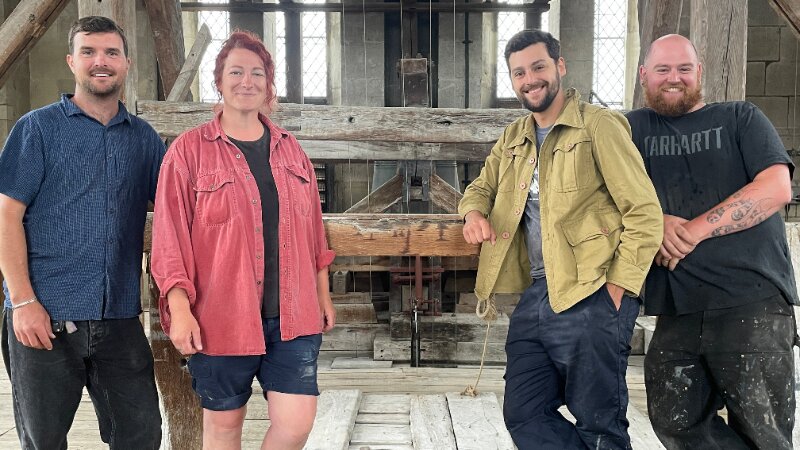
Jack Buchanan, far left, with his SPAB Fellowship colleagues Kate, Dan and Oz, inside the bell tower at Salisbury Cathedral. © Jack Buchanan
Four of us were selected from different backgrounds and disciplines. For my year there was a carpenter (Dan), a bricklayer (Kate), a blacksmith (Oz), and a stonemason (me). Together we launched headlong into travelling the length and breadth of the British Isles, taking in some of our most important buildings and historic places. We met talented craftspeople, expert practitioners, and lots of other people passionate about conservation. It’s an opportunity that I won’t get again in my career.
The Programme
The SPAB Fellowship programme consists of three 8-week blocks between March and December, allowing time between blocks to go back to work. The first two blocks were set, with a diverse programme of site visits exposing us to traditional skills, materials, and expert knowledge within the field of building conservation. We looked at practical as well as theoretical aspects, with an emphasis on the latter. The third block was of my own choosing, and I got to decide what, where, and with which craftspeople I spent my time.
It wasn’t a requirement but having a small camper van made life a lot easier. We essentially lived out of our vans and were on the road for much of the year, camping everywhere from pub car parks and lay-bys to scenic locations like Glencoe. In contrast, some hosts provided accommodation where we got to stay in beautiful homes in idyllic settings and were treated to lovely hospitality.
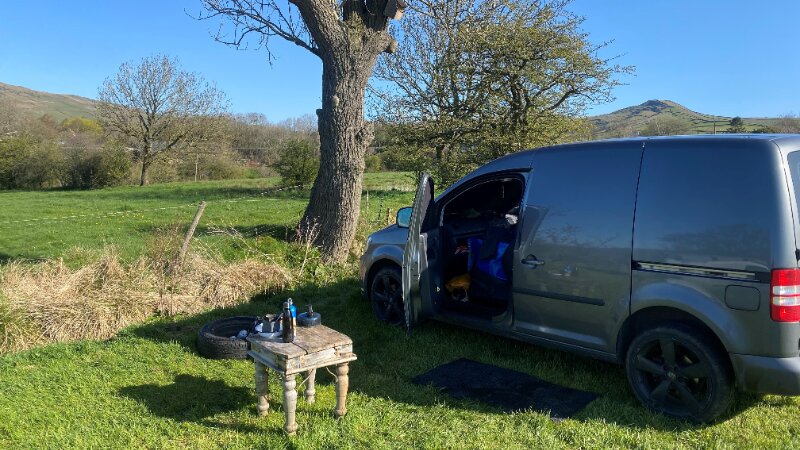
Camping spot for the night. © Jack Buchanan
Variety and collaboration
During Blocks 1 and 2, I had the opportunity to try my hand at blacksmithing, gauged brickwork, stained glass, thatching, and plasterwork to name only a few. I enjoyed gaining insight into new materials that we don’t often see in Scotland, such as timber framing and different types of earth building. The specialists we met included highly experienced architects and engineers, which lent itself nicely to working closely alongside the SPAB Scholars. The SPAB Scholarship is a training programme that runs parallel to the SPAB Fellowship, and comprises early career architects, surveyors and engineers. Working together aimed to break down any barriers that may exist between architects and craftspeople. Open dialogue was encouraged, and we all gained new and different perspectives.
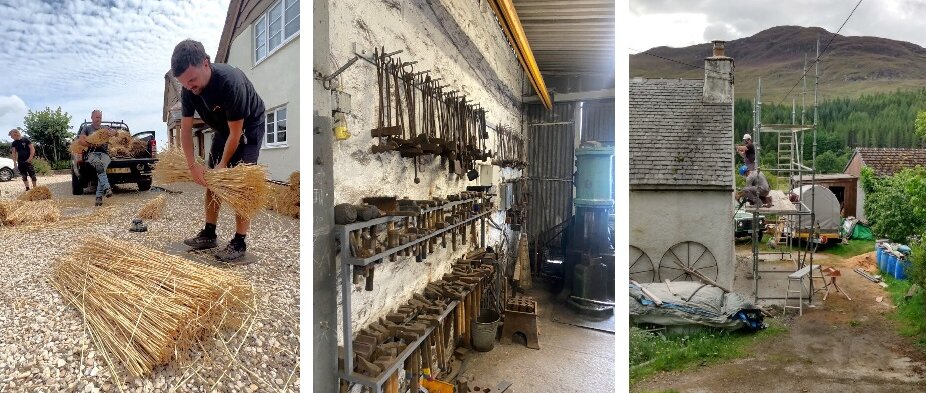
[from left to right] Thatching in Somerset. Tools at Ratho Byres Forge near Edinburgh. Lime harling a cottage in Strathconon Glen, Ross-shire. all photos © Jack Buchanan
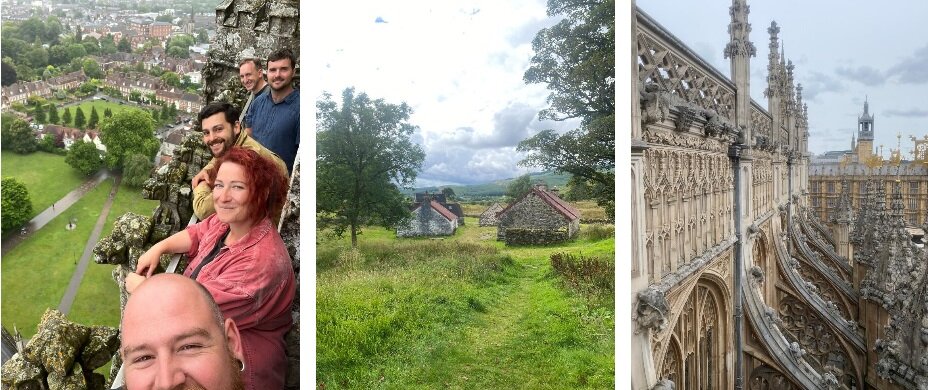
[from left to right] Up the spire at Salisbury Cathedral, with Cathedral architect Izaak Hudson. Auchindrain Township, near Inveraray – the last surviving Scottish Highland farm township. On the roof of Westminster Abbey, London. all photos © Jack Buchanan
We did not have a lot of time to spend on specific projects, but we did get the opportunity to work on things like the SPAB Old House Project Working Party; helped to re-roof a derelict church in Leicester; and worked with Lincoln Cathedral workshops. We also attended seminars and conferences such as the Building Limes Forum and the SPAB Repair of Old Buildings course.
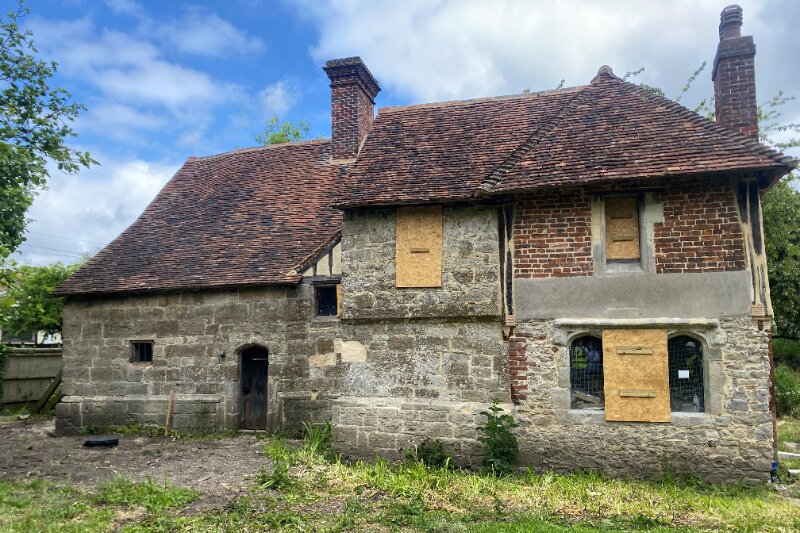
The Old House Project, Kent. © Jack Buchanan
‘Conservation Glastonbury’
The Working Party was a particular highlight of mine – think Glastonbury – but conservation is the headline act! It was a great way to meet like-minded people in a relaxed setting, and was based at Boxley Abbey, an old Cistercian monastery, and its neighbour, The Old House Project in Kent. The wide range of specialists on site gave us an opportunity to try a bit of everything, all while contributing to a live conservation project. The all-night party in the Abbey’s 13th century hospitium (thought to have originally been a hostel for Abbey visitors) was the perfect way to round off a great week!
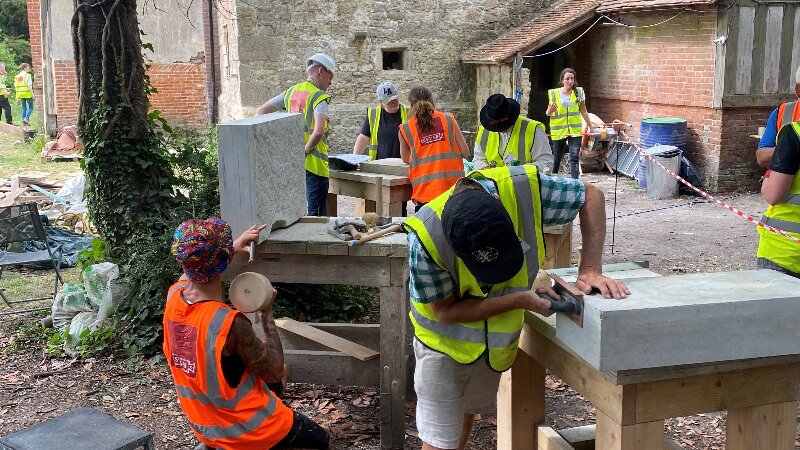
Working Party at The Old House Project, Kent. © Jack Buchanan
Specialisation and choice
For the third block I chose to specialise in my own field of stonemasonry. During the previous months, I had gathered ideas of places I wanted to see and new skills I wanted to learn – and Pip Soodeen, the programme organiser from the SPAB, did the rest! I was privileged to spend time at London City and Guilds stone carving workshop, Canterbury Cathedral, and learning from experts such as Master Mason John David at York Minster. I ended my Fellowship back in Scotland, spending a couple of weeks with stonemasonry contractors Andy Bradley and Harper & Allan respectively, each holding broad portfolios of work. I also spent time with materials scientist and building pathologist Bill Revie, looking at the technical aspects of stone types and mortars.
Looking back and looking forward
Was the Fellowship what I thought it would be? It more than surpassed my expectations. I knew that I would learn things in terms of expertise and skills, but what surprised me was the way my outlook shifted in many ways.
I have new passions and interests that I never thought I would have, like my growing appreciation for Scottish vernacular architecture. Auchindrain Township near Inveraray is the last surviving Scottish Highland farm township. It now stands as a striking reminder of this traditional way of life. In the Borders, we visited one of the last remaining cruck framed cottages in Scotland, which is thankfully in the safe hands of past SPAB Fellow Alex Gibbons. Considering how significant these places are historically and culturally, it saddens me that we have lost so much of this original architecture. I have realised that these crafts aren’t just about maintaining the physical aspects of buildings, but also safeguarding their historical significance.
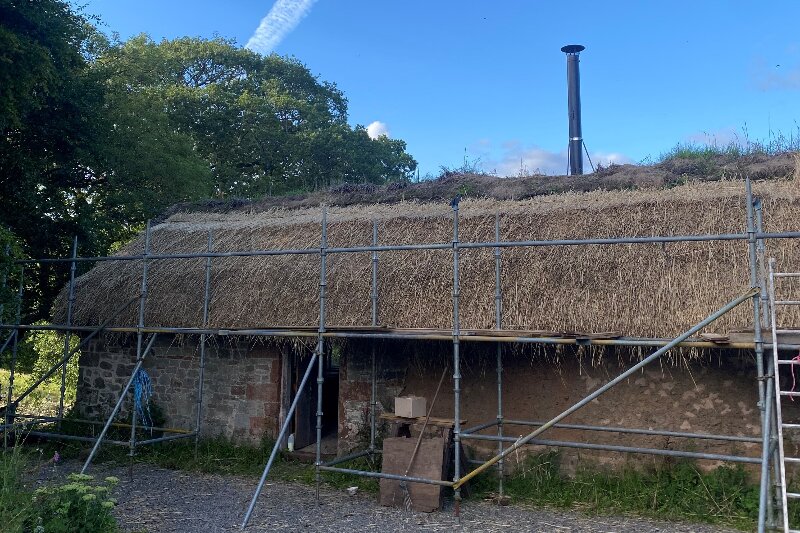
Category A listed Priorslynn in Canonbie, Dumfries and Galloway is an important example of our lost Scottish vernacular architecture, being cruck framed, cob walled (earth building using clay, sand and straw) and also thatched. © Jack Buchanan
During my time on the programme, I was struck by people’s kindness and hospitality, and their willingness to take the time to share their knowledge. As well as expanding my craft skills, I feel I grew personally. I gained invaluable perspectives that have enriched my appreciation of conservation practices, while also creating lasting memories.
Closer to home and now settled back into my role at Dumbarton Castle, I’m thankful to HES for supporting me throughout the Fellowship and extend my gratitude to the SPAB for this transformative experience. As I look ahead, I’m excited to continue my pursuit of a lifelong path of learning. The lessons I’ve learned will continue to influence my work and hopefully provide opportunities to contribute a different approach and perspective. I feel a sense of responsibility to pay it forward as a guardian of our built heritage, and it has further instilled in me the value of conserving the past to build a more meaningful future.
For anyone who’s thinking of doing it – applications for next year are open now – you won’t regret it!
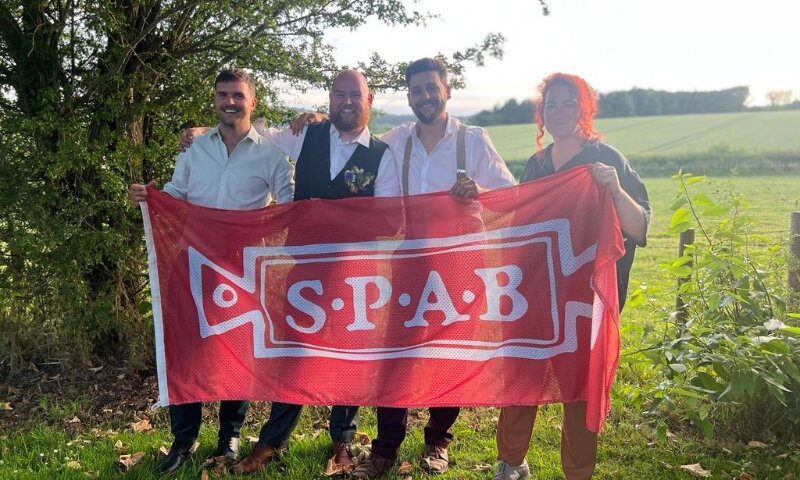
Jack Buchanan, far left, with his SPAB Fellowship colleagues Oz, Dan and Kate. ©Jack Buchanan
Find out more
To learn more about the Society for the Protection of Ancient Buildings, visit the SPAB website.
For more information and to apply for a place on the 2025 SPAB Fellowship, visit their dedicated Fellowship page.
To hear more from Jack about his experience, read his SPAB blog about Pluscarden Abbey.
To find out more about the last surviving township in Scotland, visit the Auchindrain Township website.
About the author:
Jack Buchanan
Jack Buchanan is a stonemason with a passion for conservation. He is Assistant Works Manager at HES Dumbarton Castle Depot and is a 2023 SPAB Fellow.
View all posts by Jack Buchanan



